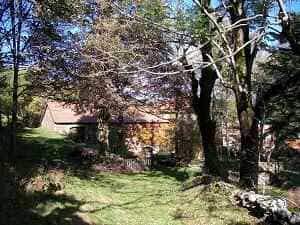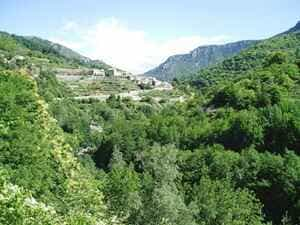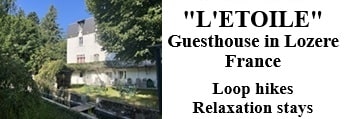41,5km bike tour at La Bastide-Puylaurent |
From L'Etoile, head towards the centre of the village and take the direction of Villefort opposite until the Pradillou roundabout. Turn right and follow the D906 for 800m. Take the old abandoned road on your left for 5.7km. Find the D906 which you follow for 2.7km. Turn left and follow this small road for 11.2km via Planchamp and up to Pantostier. Turn left on the D151 and go up to La Bastide-Puylaurent via Les Baumes, the Roujanel dam, Chalbos and Alzons.

20,5km - 25km - 27,7km - 30km - 35,2km - 37km - 41,5km - 44km - 48,4km - 57,5km - 59,4km - 60km - 60,5km - 69km - 70km - 76,8km - 77km - 81km - 90km - 95,7km







 Distance: 41.5km. Maximum altitude: 1086m. Minimum altitude: 396m. Cumulative elevation: 1321m.
Distance: 41.5km. Maximum altitude: 1086m. Minimum altitude: 396m. Cumulative elevation: 1321m.
IGN maps: La Bastide-Puylaurent (2738E). Largentiere la Bastide-Puylaurent Vivarais Cevenol (2838OT).
Print the route - Electric bike rental
Located in the Mont Lozere massif, the Borne valley is distinguished by its steep gorges, dug by the Borne river. The contrast between the granite cliffs and the lush vegetation is striking. The level of the river varies between 550m and 305m above sea level, while that of the plateau rises to around 1000m above sea level. This granite massif has a special history: it was separated from Mont Lozere by the Villefort fault, a major geological event dating back 305 million years. This fault, oriented north-south, created a unique landscape, marked by rugged reliefs and impressive rock formations.
The Borne separated the Vivarais from Gevaudan with the Chassezac, which heads towards the Ardeche. The hamlet of Pied de Borne was promoted, on September 29, 1964, to the rank of capital of the commune by the merger of the communes of Balmelles, Planchamp and Saint-Jean-Chazorne, following the hydroelectric development of Chassezac. The deep gorges of Chassezac are dug over 4 km in the granite in a northwesterly direction up to Garde-Guerin. Planchamp is located on a hillside above Chassezac, 9 km northeast of Villefort. Small modern castle of Barrot. Odilon Barrot was a lawyer and politician during the Second Republic and the Second Empire. On a rocky spur, Sainte-Madeleine chapel in a listed site. Pied de Borne located at the intersection of three magnificent rivers: the Altier, the Borne and the Chassezac. The variety of the relief, steep and rocky on the mountain slopes, uniform on the Roure plateau gives the landscape a colorful range of crops, the main ones of which remain the chestnut (the famous "Sardoune" of La Borne is a delicious chestnut) and the cherry.
The construction of irrigation channels, particularly in the 18th century, and the cultivation in terraces (bancels) bear witness to this. The variety of the relief, steep and rocky on the mountain slopes, uniform on the "Roure" plateau gives the landscape a colorful range of crops, the main one of which remains the chestnut. The famous "Sardoune" of La Borne is a delicious chestnut marketed in particular by Fariborne, a producers' cooperative that has just opened a new manufacturing workshop on the territory of the commune.
This very diverse site includes old beech forests, mountain megaphorbiaies (tall grass formations). rocky environments. purgative broom moors and watercourses. On the latter. we observe the presence of a rare dragonfly: the Cordulegastre bidentate, present in very small numbers in Ardeche and confined to the Ligne valley. The local fauna remains generally poorly known. With regard to the flora and forest habitats. better prospected, the presence of interesting environments and rare plants deserves to be noted. The upper Borne valley forms a very particular entity, given its very steep relief and its birdlife; it includes the Bois de Bouquet.
These gorges characterized by a very rugged relief, with many cliffs, are inhabited by birds of prey such as the Peregrine Falcon and the Eagle Owl and constitute a wintering site for the Alpine Accentor and the Wallcreeper; the Golden Eagle also nests there. The right bank slope is kept open by pastoralism and has a warm microclimate (the daffodil blooms there in February), while the opposite slope is covered by a climax beech-fir forest (this is the term used to describe an ecosystem that has reached the theoretical culmination of its natural evolution, in balance with the soil, the climate and all its components, and which is self-generating). This is home to subalpine botanical stations (with such remarkable plants as the Selaginian Lycopod or the Clasping-leaved Streptope).
The Silver Fir thus rubs shoulders with the Chestnut, which fruits up to 950 m above sea level; but the Peregrine Falcon, the Eurasian Eagle Owl and the Wallcreeper ignore these contrasts and evolve indifferently on both slopes... The Pratazanier stream, very steep, is interesting as much for its flora as for its fauna. An old beech forest shelters a yellow Gagee station, while the Ron Corbier is frequented by rock avifauna. The geographical position of the middle valley of the Borne flowing from North/North-East to South/South-West individualizes this wooded area: the rocky element changing from gneiss to schist. is important. In the absence of the Silver Fir and despite the conifer plantations covering the rocky slopes, the beech forest occupies the cool slopes while the oak forest colonizes the sunny sides, the chestnut forest occupying rather the valley bottoms.
